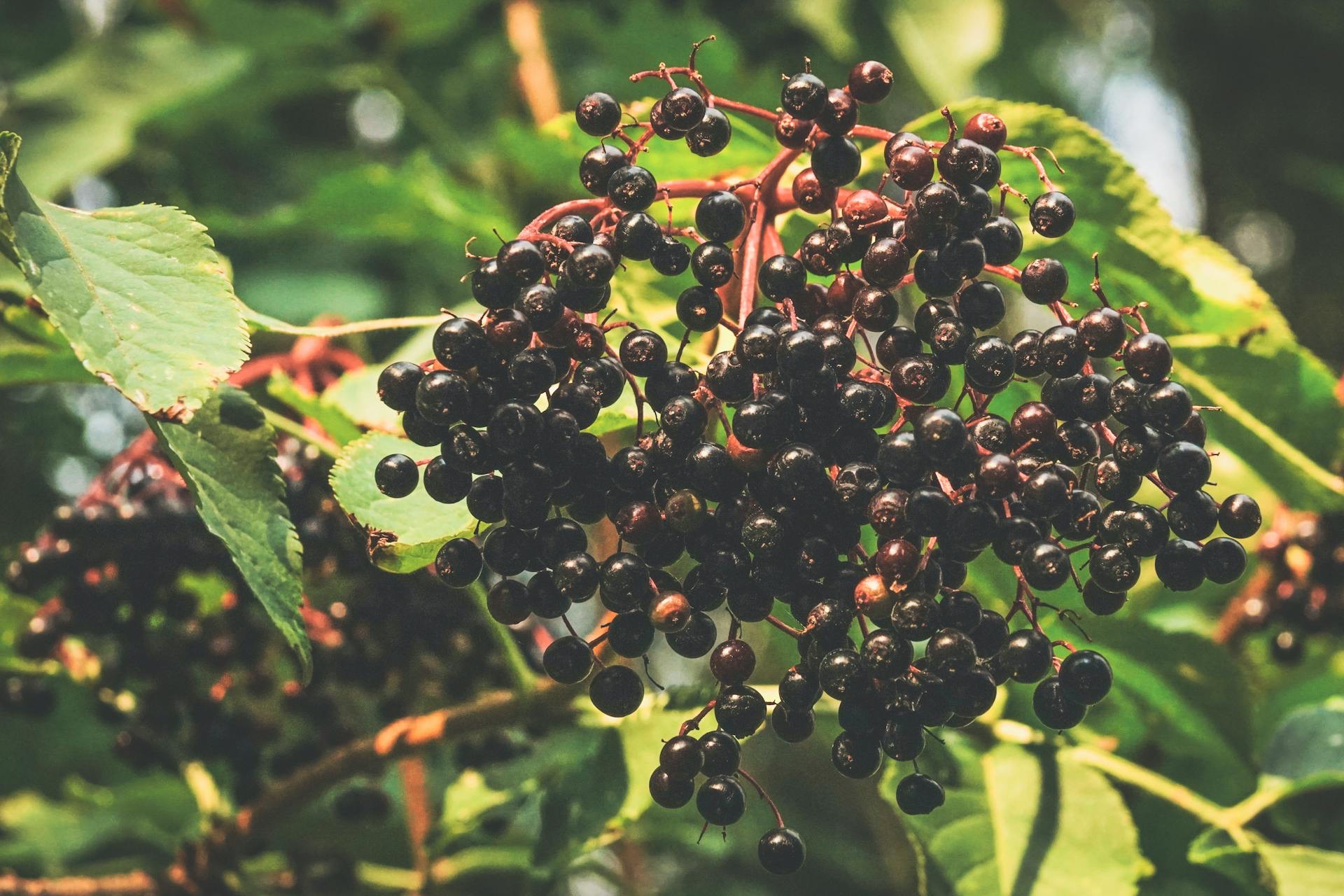Botanical Basics
- Common Name(s): Elderberry, European Elder, Black Elder
- Folk Name(s): Elder, Pipe Tree, Bore Tree, Lady Elder, Tree of Doom, Hollerbusch
- Scientific/Latin Name: Sambucus nigra (European Elder); Sambucus canadensis (American Elder)
- Family: Adoxaceae (formerly Caprifoliaceae)
- Plant Type: Deciduous shrub or small tree
- Botanical Description: Elderberry grows 10–30 ft tall with multiple stems, gray-brown bark, and pithy young twigs. Leaves are pinnate with serrated margins, opposite in pairs. Creamy white flowers form broad clusters (corymbs), followed by small, dark purple-black berries.
- Growing Zones/Climate: USDA Zones 3–9; prefers temperate climates
- Best Zones for Growth: Widely adaptable, thriving in moist, fertile soils in zones 4–8
- Habitat & Range: Native to Europe, North America, and parts of Asia; grows in hedgerows, forest edges, streambanks, and moist meadows
Cultivation & Harvest
- Soil & Sun Requirements: Prefers moist, well-drained soil rich in organic matter; full sun to partial shade
- Propagation: Easily grown from cuttings, suckers, or seeds (though seeds require stratification)
- Companion Planting: Pairs well with mint, lemon balm, comfrey, and yarrow; often grown near orchards as a pollinator attractant
- Harvesting Guidelines: Flowers harvested in late spring/early summer; berries in late summer to early autumn when fully ripe (dark purple/black)
- Drying/Preservation: Flowers can be air-dried in shade; berries may be dried, frozen, or processed into syrups, tinctures, jams, and wines
Traditional & Historical Use
- Cultural Significance: Revered in European folklore as sacred to the Elder Mother spirit; often planted near homes for protection
- Traditional Medicine: Long used for fevers, colds, influenza, and respiratory infections; flowers used as diaphoretics and anti-inflammatories
- Symbolism: Associated with protection, transformation, and boundaries between worlds
Medicinal & Practical Properties
- Active Constituents: Flavonoids (including quercetin and rutin), anthocyanins, vitamin C, tannins, and volatile oils
- Medicinal Uses: Immune support, cold and flu remedy, antioxidant, mild laxative, diuretic, anti-inflammatory
- Preparation Methods: Syrups, teas, tinctures, wines, lozenges, infused honeys
- Dosage & Guidelines: Standard syrup dosage is 1–2 tsp daily for prevention; up to 1 Tbsp every few hours when ill (varies by preparation)
- Safety/Precautions: Raw berries, seeds, and other plant parts contain cyanogenic glycosides and can cause nausea/vomiting; must be cooked before use. Avoid in pregnancy and with autoimmune conditions unless under guidance.
Magical & Spiritual Properties
- Elemental Association: Water
- Planetary/Deity Correspondence: Venus, Hecate, Holda, the Elder Mother
- Magical Correspondences: Protection, banishing, transformation, healing, communication with spirits
- Ritual Use: Branches used for wands; berries and flowers in protective charms, healing spells, and offerings; often planted as a guardian tree
- Symbolism in Divination/Dreams: Represents thresholds, endings that lead to beginnings, spiritual insight, and ancestral connection
Ecological & Culinary Uses
- Pollinator Value: Flowers attract bees, butterflies, and other beneficial insects
- Wildlife Uses: Berries provide food for birds, small mammals, and deer; thickets offer shelter for wildlife
- Culinary Uses: Cooked berries used in syrups, jams, jellies, wines, cordials, pies; flowers made into elderflower cordial, fritters, and teas
Household/Practical Uses
- Quick Uses: Antiviral syrups, immune tonics, jams, wines, floral cordials, protective charms
- Notable Traits: Highly adaptable plant, sacred in folklore, powerful antiviral properties backed by modern studies
- Special Notes: Always cook berries; never consume raw. Associated with both healing and the spirit world.
TOXIC: Elderberries (Raw/Unripe)
- Toxin: Elderberries, especially when raw or unripe, contain cyanogenic glycosides, the same family of compounds found in apple seeds and stone fruit pits. These compounds can release small amounts of cyanide in the body. The leaves, stems, and seeds have higher concentrations than the ripe fruit.
- Danger Level: Eating raw berries—even a handful—may cause unpleasant symptoms such as nausea, vomiting, diarrhea, and abdominal cramps. Larger amounts, or consuming the stems and leaves, can be more dangerous and have been linked to more serious cases of poisoning. Children are especially sensitive.
- Practical Note: The good news is that proper preparation destroys the toxin. Cooking elderberries (for syrups, jams, pies, wines, and teas) neutralizes the harmful compounds and makes them safe to enjoy. Always remove leaves, stems, and seeds before cooking or processing. Never use the raw plant parts directly in food or medicine.
- Traditional & Modern Use: Once prepared safely, elderberries have a long history in herbalism as a supportive immune tonic, especially for colds and flu. They’re rich in antioxidants, vitamins, and flavonoids, which is why elderberry syrup is a popular home remedy.

Supporting Notes
- Hoffmann, David. Medical Herbalism (2003)
- Chevallier, Andrew. Encyclopedia of Herbal Medicine (2016)
- Grieve, M. A Modern Herbal (1931)
- Barsett, Hilde et al. “Elderberry and the immune system” (Journal of Functional Foods, 2019)
- Foster, Steven & Duke, James. Peterson Field Guide to Medicinal Plants and Herbs
No comments:
Post a Comment